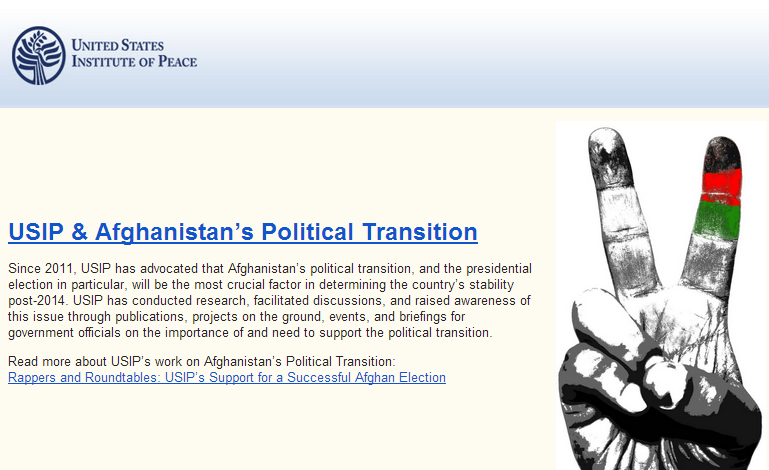USIP & Afghanistan’s Political Transition
Source: United States Institute of Peace
Since 2011, USIP has advocated that Afghanistan’s political transition, and the presidential election in particular, will be the most crucial factor in determining the country’s stability post-2014. USIP has conducted research, facilitated discussions, and raised awareness of this issue through publications, projects on the ground, events, and briefings for government officials on the importance of and need to support the political transition.
Read more about USIP’s work on Afghanistan’s Political Transition:
Rappers and Roundtables: USIP’s Support for a Successful Afghan Election

Why Afghanistan’s Provincial Council Elections Matter
Peace Brief by Noah Coburn and Anna Larson
March 26, 2014
With elections scheduled for April 5, Afghanistan’s Provincial Councils offer one of the best hopes for the future of local democracy in the country. The significance of Provincial Councils, including creating an opportunity for a new generation of young Afghans to begin political careers, has often been overlooked but has steadily increased.

Last Chance: The International Community and the 2014 Afghan Elections
Peace Brief by Scott Smith
March 14, 2014
Afghanistan’s April 5 election could create space for political elites to address root causes of the country’s continuing crisis, despite the past divergence between Afghan and international views on what elections can accomplish. With more realistic expectations, informed in part by a better understanding of the 2009 elections, the Afghans may be more determined to take this possibly final opportunity to rescue themselves from a political implosion.

How will the Taliban Respond to Afghanistan’s Elections?
Olive Branch blog post – Peace Brief Summary by Tom Omestad
February 18, 2014
As Afghanistan moves toward April 5 elections for president and provincial councils, key questions loom: Among them, just what will the Taliban do to disrupt or distort that nation’s exercise in democratically selecting its leadership, and what might those efforts accomplish?
 Afghan Women Challenge Presidential Candidates in Forum
Afghan Women Challenge Presidential Candidates in Forum
Olive Branch blog post by Nicoletta Barbera
February 6, 2014
“It should not only be in words that we say women comprise 50 percent of the society,” said Muhammad Yosuf Nooristani, chairman of Afghanistan’s Independent Election Commission. The country must “really give them the chance to participate.” Nooristani made these comments at a USIP-sponsored national conference in Kabul this week that gathered more than 220 women leaders in civil society to discuss the upcoming presidential and provincial elections scheduled for April 5.

Youth Mobilization and Political Constraints in Afghanistan: The Y Factor
Special Report by Anna Larson and Noah Coburn
January 13, 2014
As Afghanistan’s youth population grows, so do youth aspirations for political reform and access to economic resources. Yet old-guard leadership marginalizes new groups and challenges to the status quo. This study of youth in two districts and at Kabul University finds that increased political activism by youth is not translating to more effectiveness in reforming the patronage networks that dominate the Afghan political system. Youth organizations that appear apolitical, such as sports clubs, may be the forums where youth mobilize more effectively.

Getting it Right in Afghanistan
USIP Book by Moeed Yusuf, Scott Smith, and Colin Cookman, editors
December 2013
As the United States and NATO prepare to withdraw their troops from Afghanistan in 2014, the question remains as to what sort of political settlement the Afghanistan government and the Taliban can reach in order to achieve sustainable peace. If all parties are willing to strike a deal, how might the negotiations be structured, and what might the shape of that deal be? Getting It Right in Afghanistan addresses the real drivers of the insurgency and how Afghanistan’s neighbors can contribute to peace in the region.


